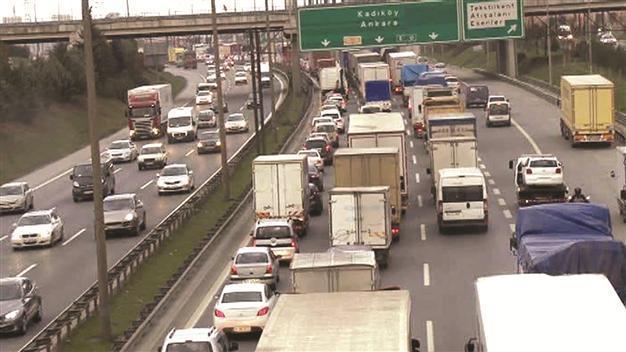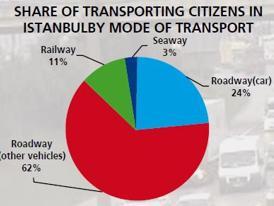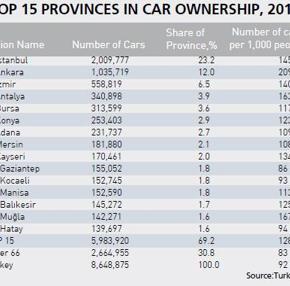‘Car mania’ spreads like wildfire in big Turkish cities lacking infrastructure
MUSTAFA SÖNMEZ - mustafasnmz@hotmail.com

One quarter of 13.5 million trips are made by privately-owned cars in Istanbul in a day. When other road vehicles are added, this increases to 87 percent, making Istanbul a city which becomes more and more unbearable to live. DHA photo
Heavy traffic makes our lives unbearable in big cities, especially in Istanbul. Let’s have a look at what the 2014 Program of the government says: “Extreme fuel consumption, environmental degradation, car accidents and heavy traffic have been intensifying due to rapid and unplanned urbanization, rapid population growth and a dramatic rise in the ownership of cars.”Cars kill
The transportation policies are mainly based on the development of roads and highways for cars in Turkey. This is one of the biggest reasons why we’re that suffering from heavy traffic actually. The more car ownership rises, the more roads are developed for them. The solution should be sought somewhere else.
The 4th article of the 1992 European Urban Charter said the following: “Cars kill a city gradually. We’ll choose either our city or our cars in the 2000s as these two cannot live together.”
One quarter of 13.5 million trips are, however, made by privately-owned cars in Istanbul in a day.
When other road vehicles are added, this percentage increases to 87 percent, making Istanbul a city which becomes more and more unbearable to live in day by day. Some 2 million cars are on the roads in Istanbul every day, to which some 100,000 other road vehicles should be added. While some 24 percent of all trips are made by 99 percent of vehicles, 76 percent of them are by 1 percent of vehicles in Istanbul.
The share of rail systems is not more than 10.5 percent and of sea vehicles is just 2.5 percent in the daily transportation of Istanbul.
 Car mania
Car maniaBig cities’ streets are full of cars, which are produced by Oyak-Renault, Ford, Tofaş, Hyundai and Toyota in Turkey, or imported from abroad. And these streets do not have enough car parks and a majority of houses lack garages. The car stock increased by 6 percent on average annually between 2007 and 2012. This means some 600,000 cars enter into the traffic in a year, excluding commercial vehicles, minibuses and buses. While there were 6.5 million cars on roads in Turkey in 2007, this figure increased to over 9 million in 2013.
Some 500,000 new cars create extra burden on roads, bridges and car parks. Car and human queues are inevitable in this picture.
Imported cars
The number of cars for 1,000 people was 92 in 2007, but this figure increased to 114 in 2012, when some 556,000 cars were sold. Most surprisingly, only one quarter of these cars were home-grown, and others were imported.
Volkswagen was the most imported brand. Some 410,000 cars were imported in 2012. Turkey, which has been suffering from a huge current account deficit, pays millions of dollars to import cars. The Turkish state contributed to this by facilitating imports, providing cheap foreign currency. Banks also play their part by offering cheap car loans to Turkish consumers, totaling around 8 billion Turkish Liras in a year. The loans which are provided by automotive firms are excluded from this equation. Such a car love is enabled by borrowing money in the absence of the required infrastructure…
 Back to Istanbul
Back to Istanbul Most of the cars are in Istanbul to be sure. Over 23 percent of the total car stock is in this city, but the number of cars per 1,000 people is the highest in the capital city of Ankara, not Istanbul. There are some 209 cars per 1,000 people in Ankara, although there are 145 cars in Istanbul, which also hosts many poor people. Ankara hosts some 12 percent of the total automotive stock of the country.
It is insane to turn on green lights to imported cars unless comprehensive urban planning is carried out and public transportation systems are developed.
What about subways?
The best alternative to transportation by privately-owned cars is public transportation systems, especially subways. A subway system was opened in London in 1863 and in New York in 1904. Most of the European cities developed their first subways at the beginning of the 20th century, but Istanbul met this system in 2000. There are 35 subway stations in Istanbul, and the share of this system is not more than 11 percent of the whole city’s transportation. There are 22 stations in Ankara, and the share of the system is estimated to be not more than 5 percent.
There are rail transportation systems, including subways, light-railed trains and trams, in 11 big cities of Turkey, including Istanbul, Ankara, İzmir, Adana, Bursa, Eskişehir, Kayseri, Samsun, Antalya, Konya and Gaziantep. The municipalities of these cities try hard to be able to invest more in these systems, but they cannot afford it. This is mainly caused by the fact that only 10 percent of the state budget can be used by municipalities, although some 90 percent by the central government. What happens next? The government wants to keep being an authority in making such investments.
The Ministry of Transportation aims to open two subway projects in Ankara by the coming March elections, which are the Kızılay-Çayyolu subway and Batıkent-Sincan subway. Another subway project between Tandoğan and Keçiören in Ankara is also planned to be completed in the next year. The ministry has also taken over some subway projects in Istanbul, including Bakırköy-Beylikdüzü, Bakırköy-Kirazlı and 4.Levent-Darüşşafaka projects, once owned by the metropolitan municipality of Istanbul.
Cities or cars? Which one do you prefer? Each urban voter should ask this question to the candidates for mayors. The answer will be litmus paper.
















